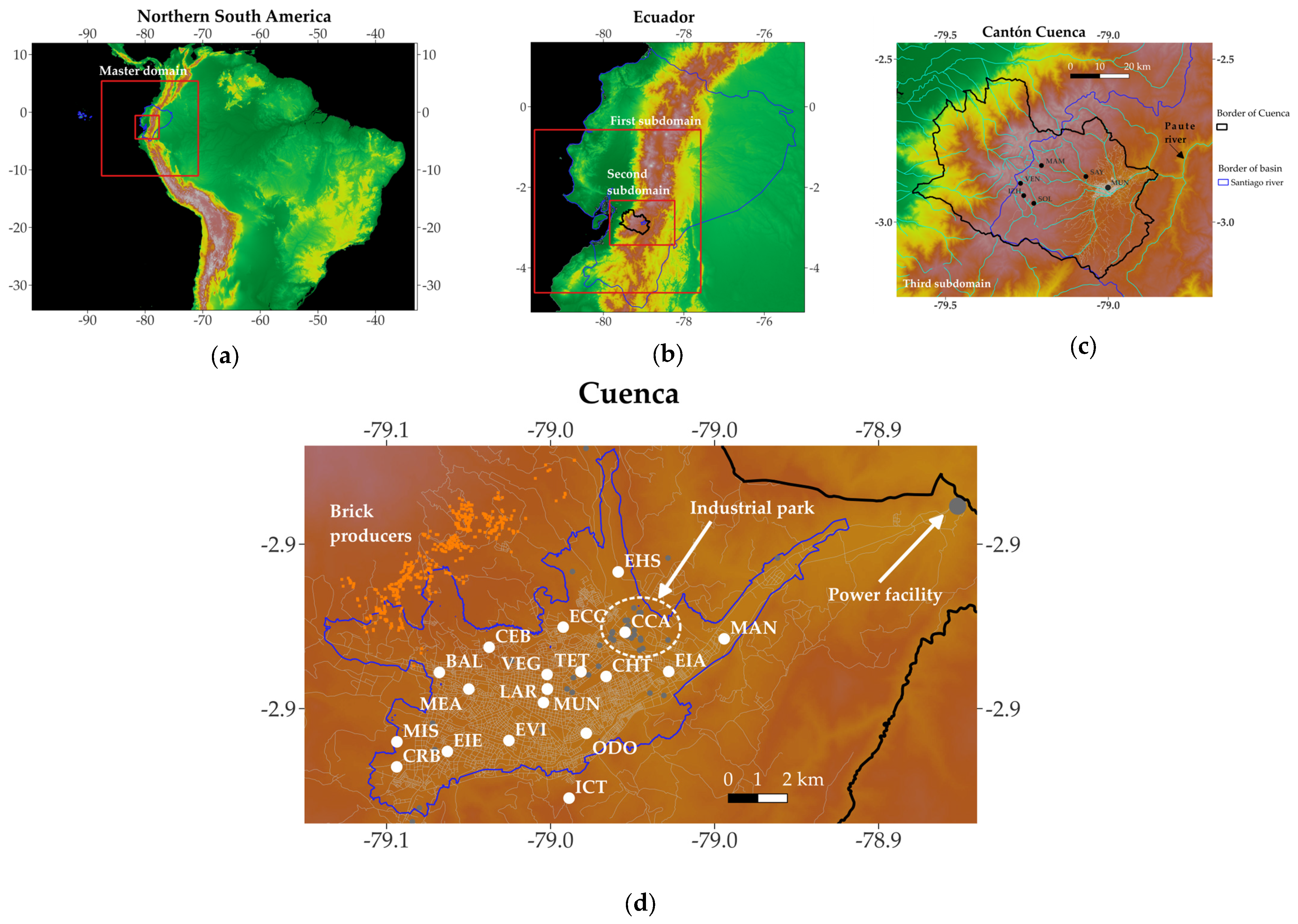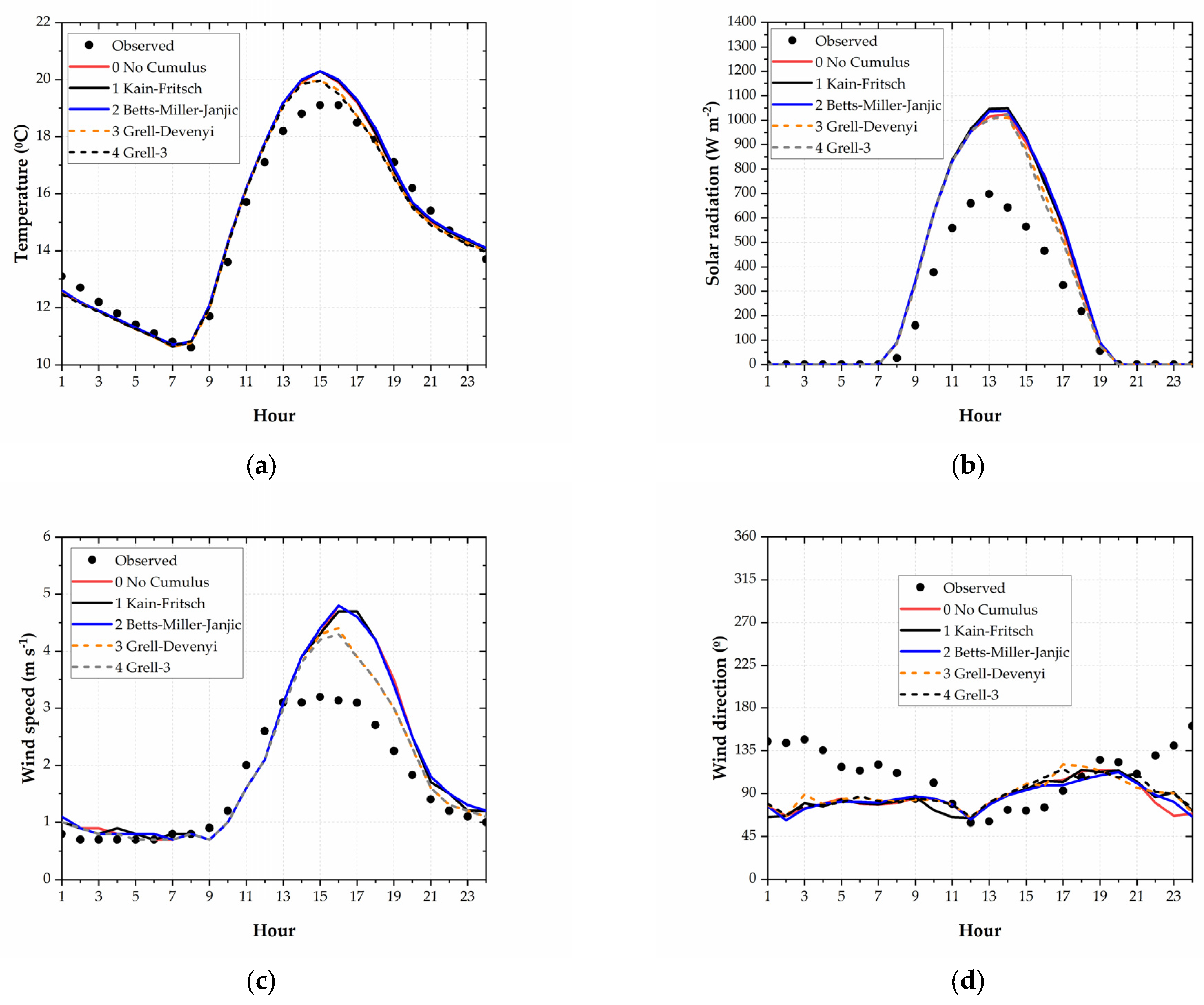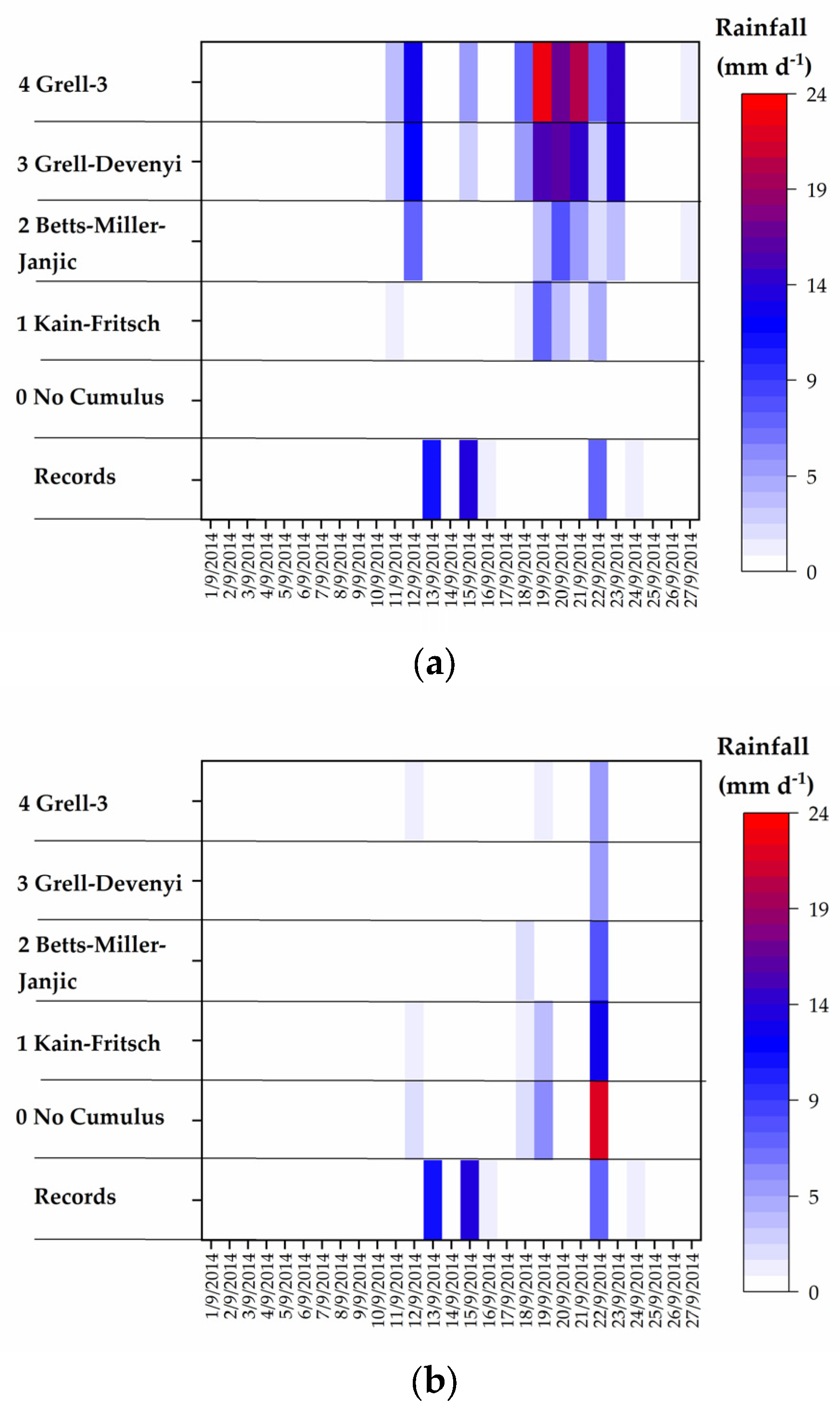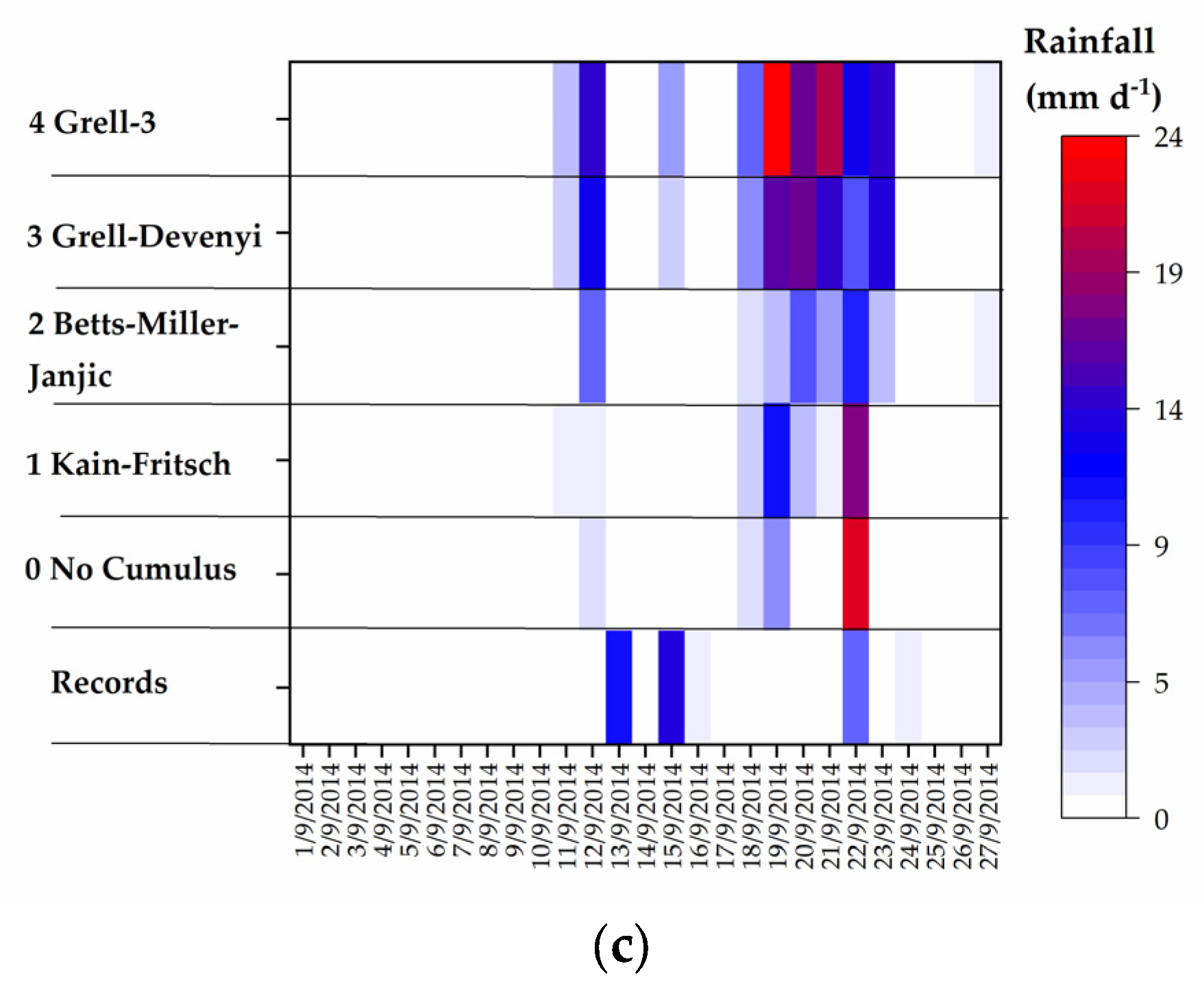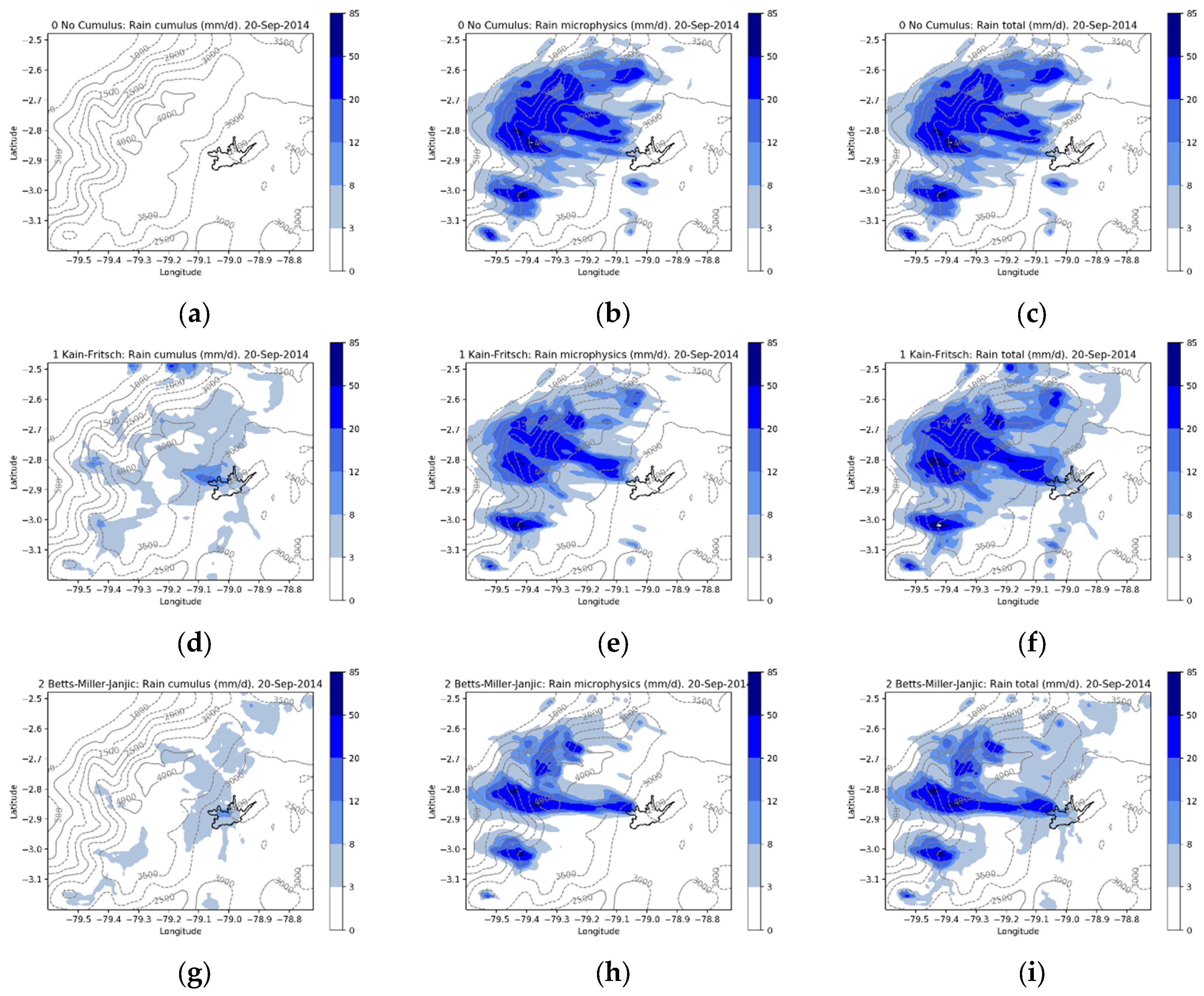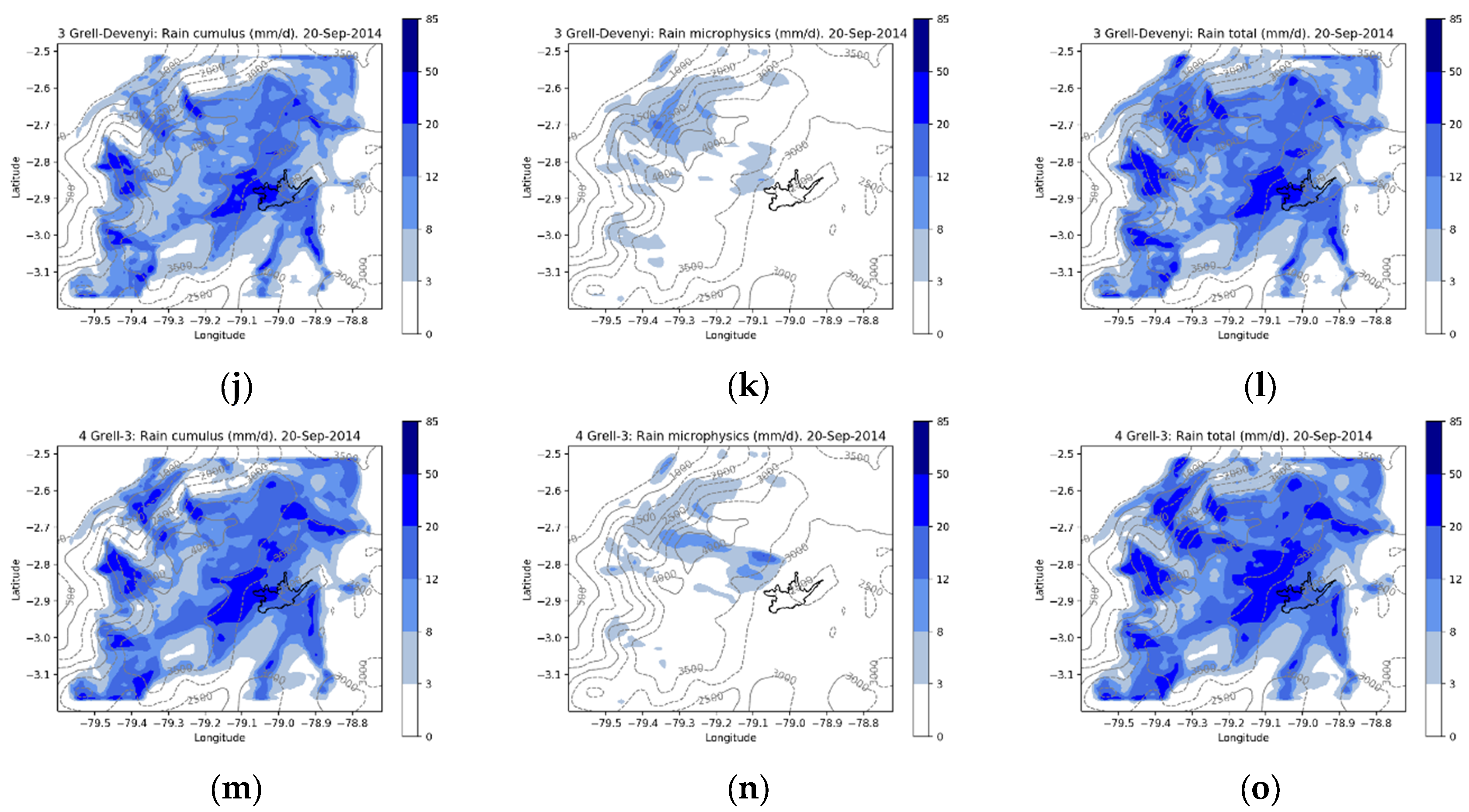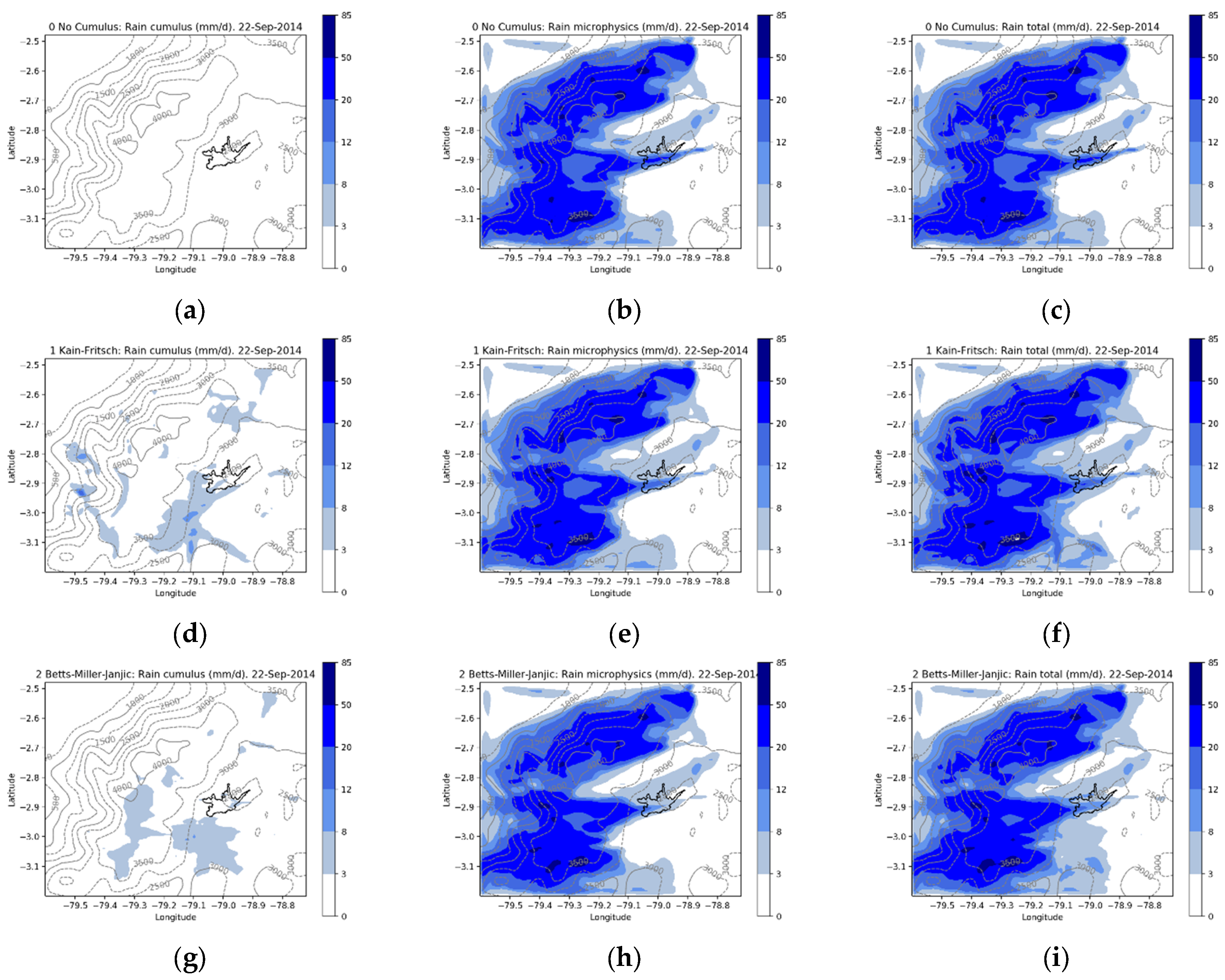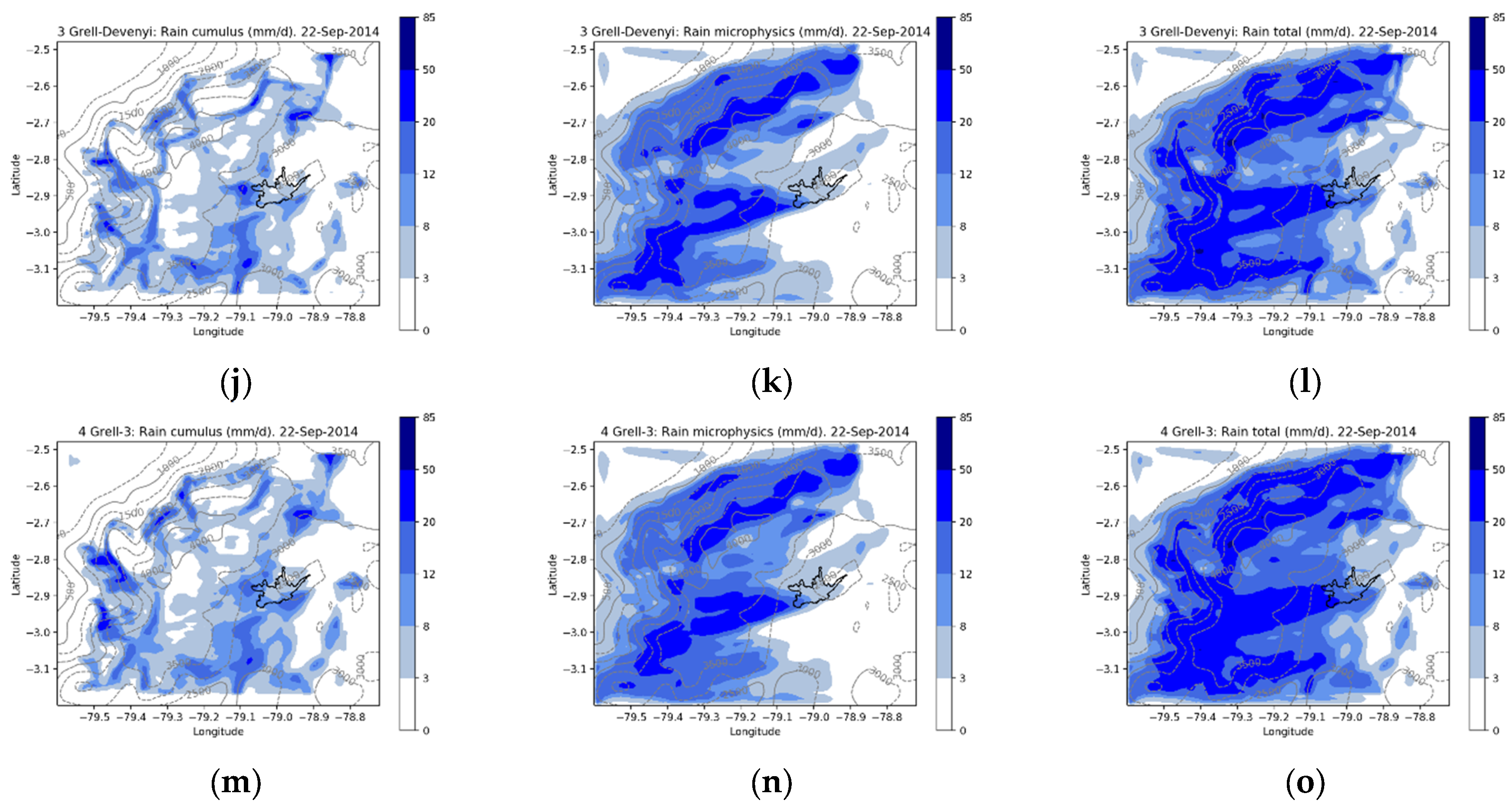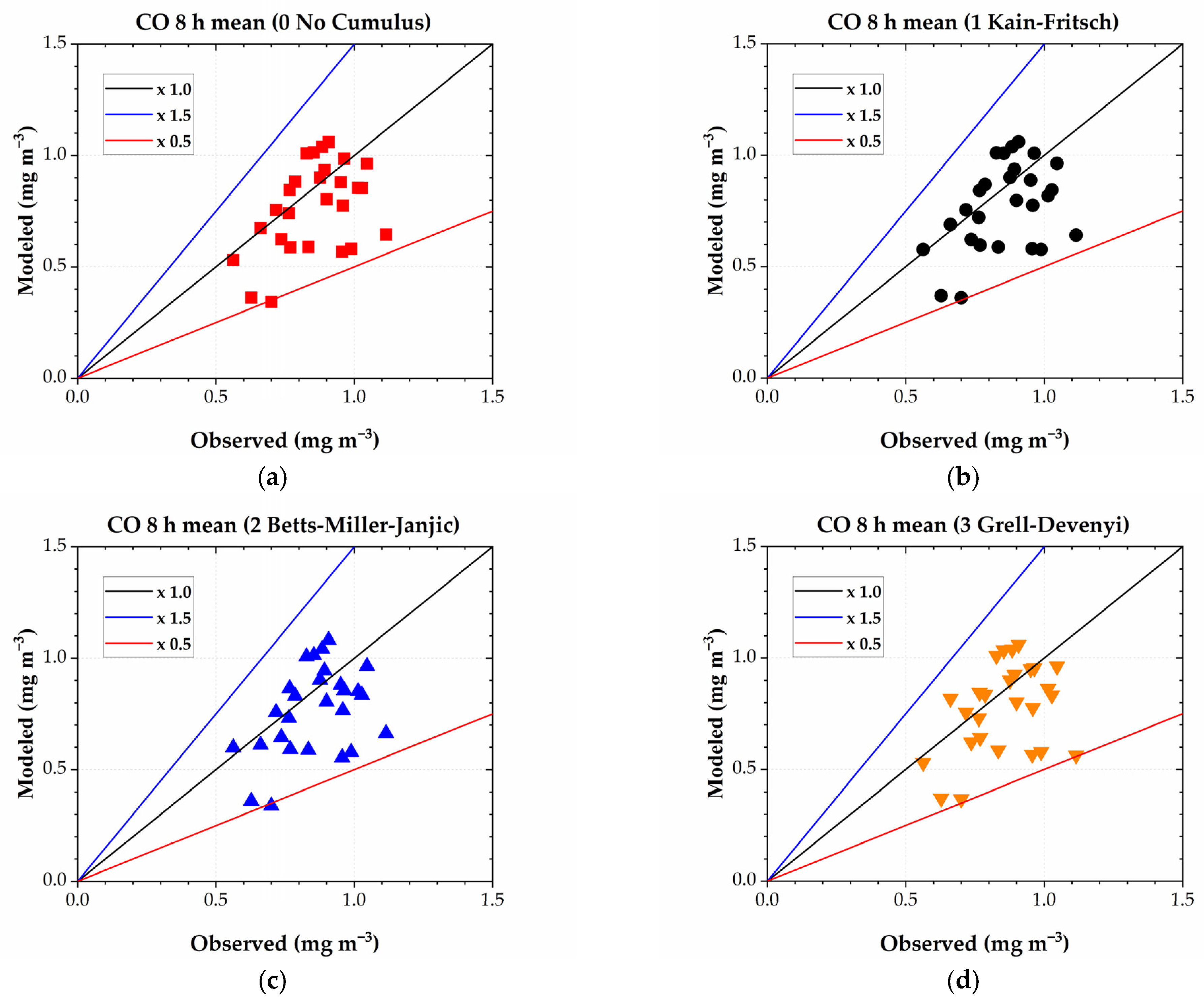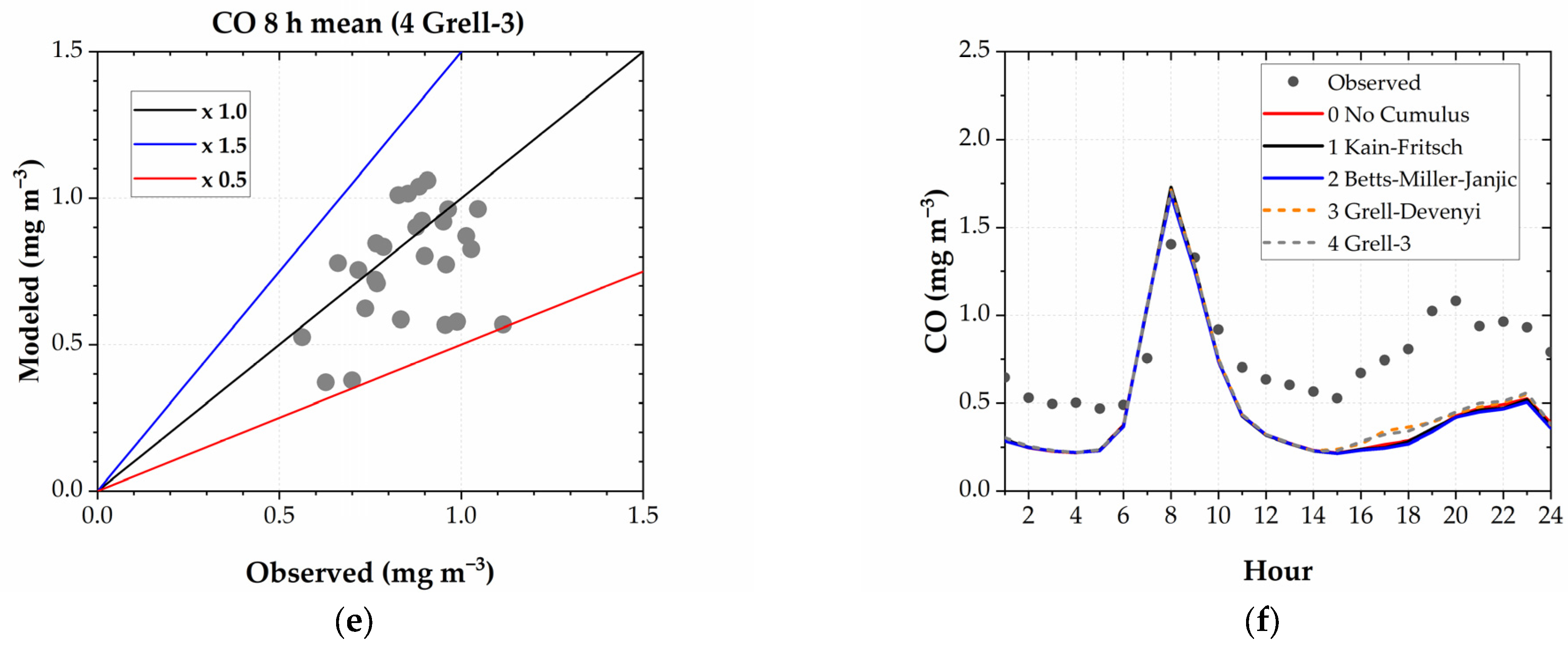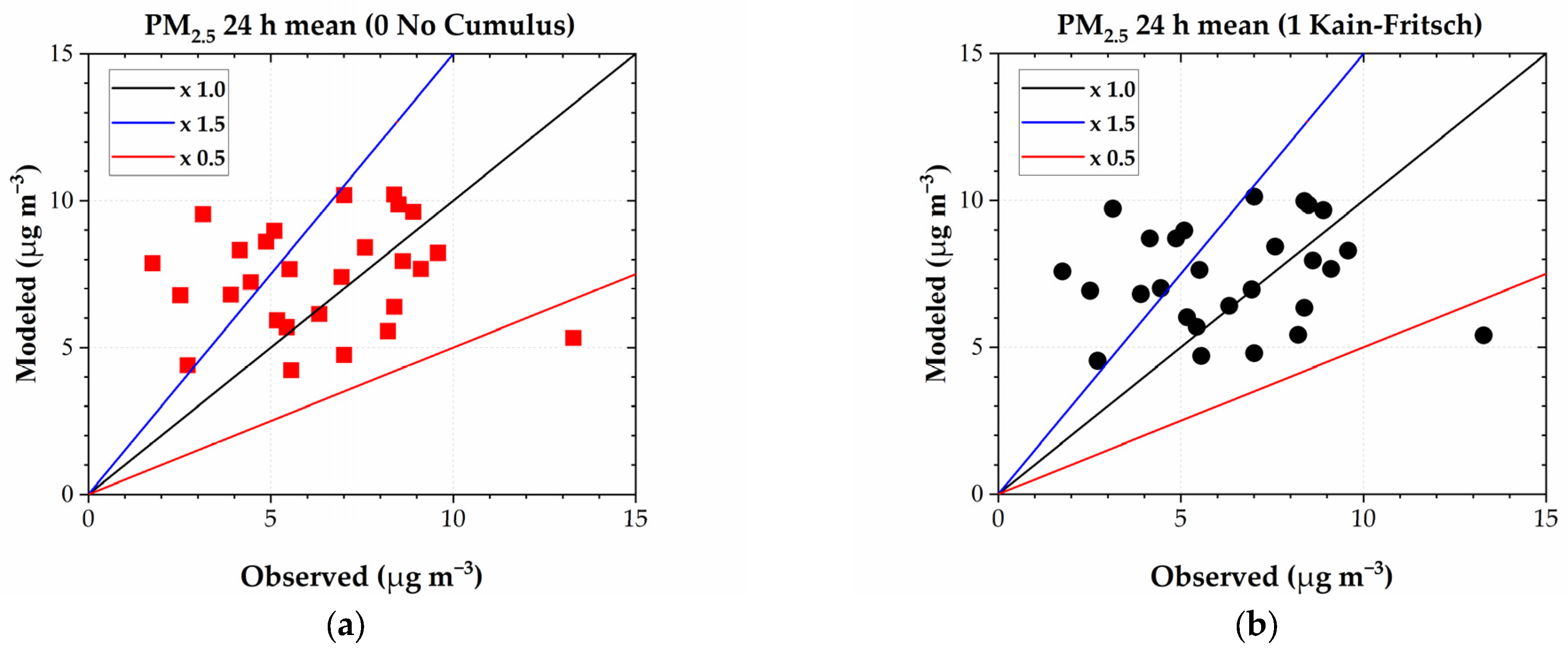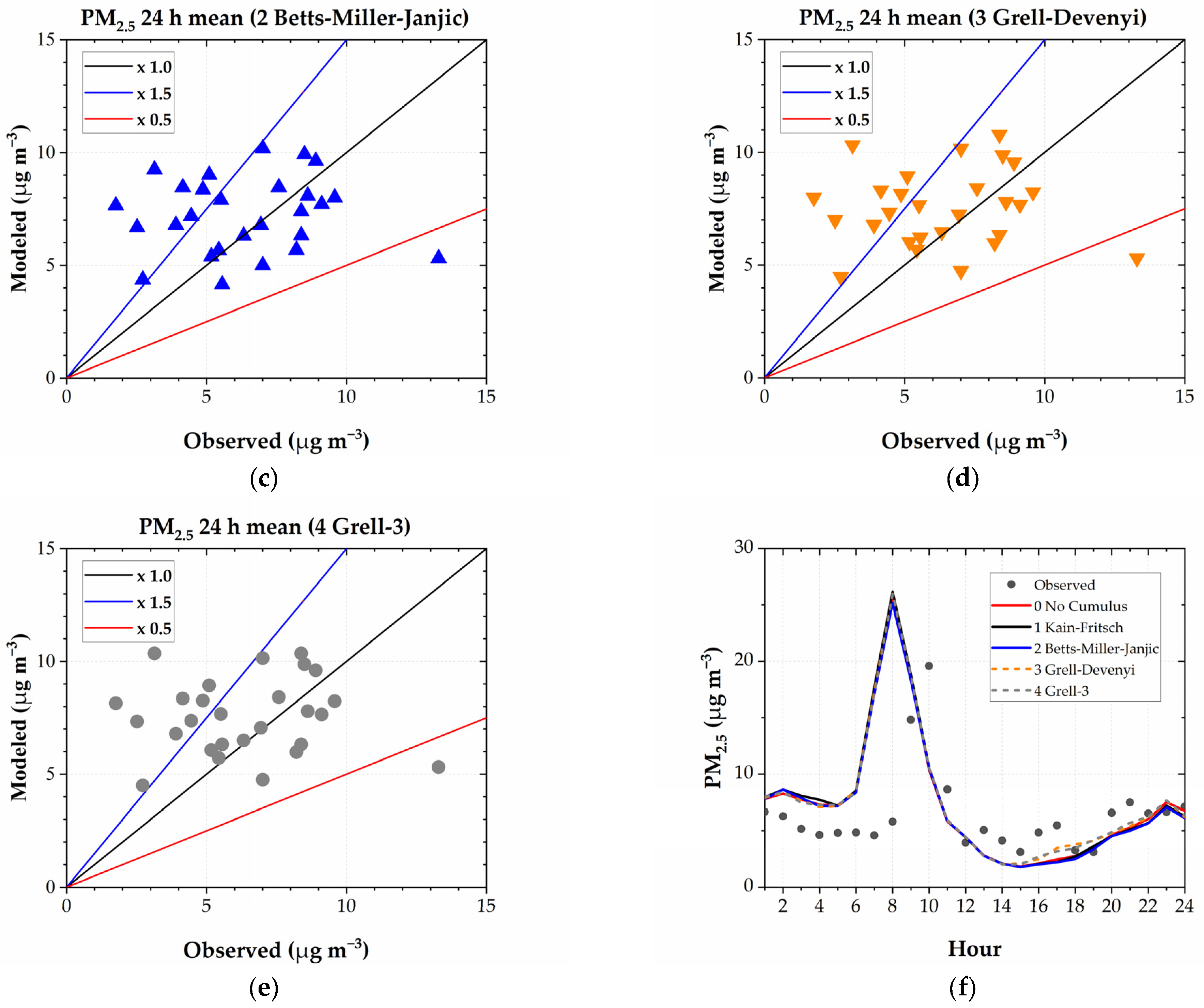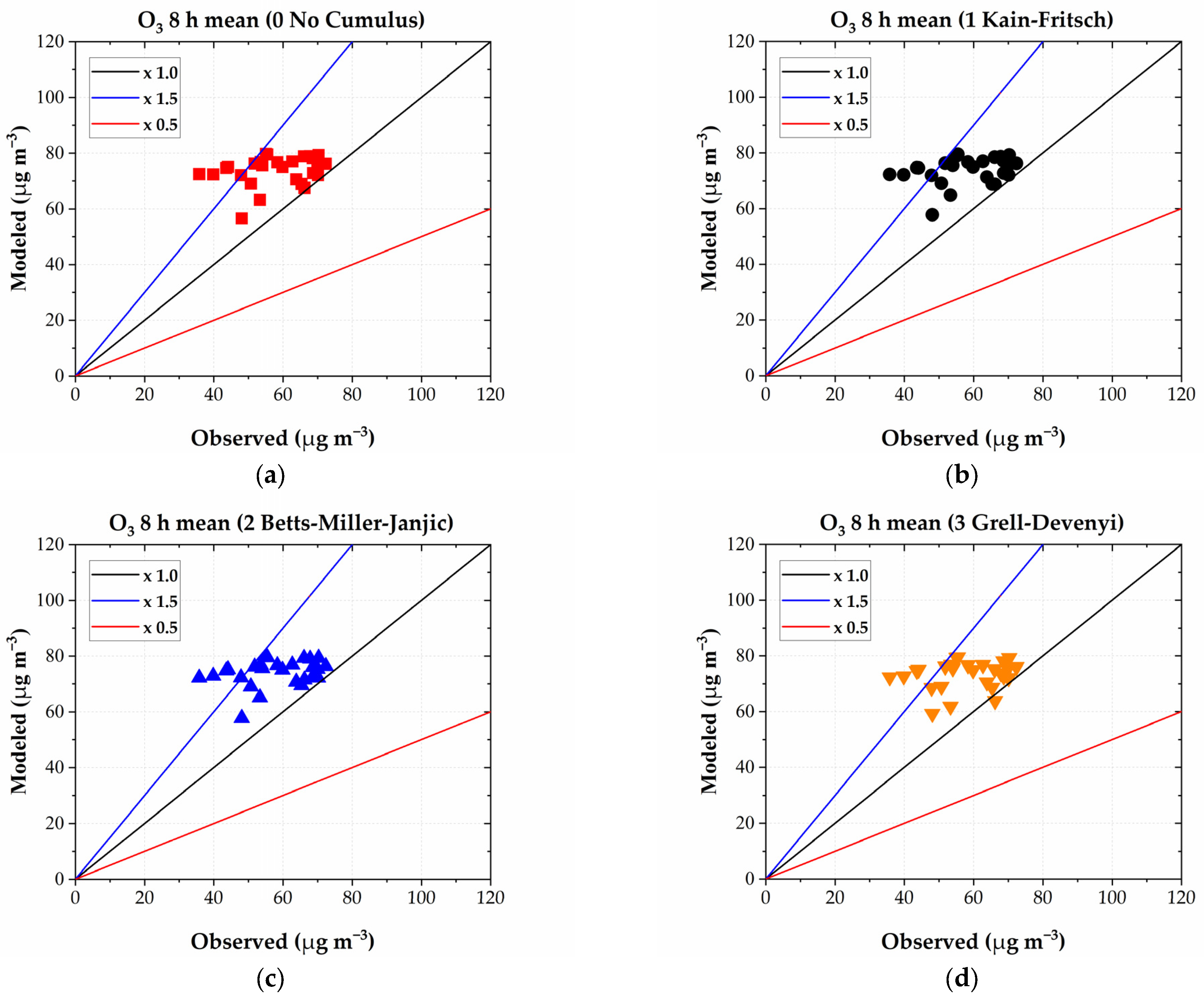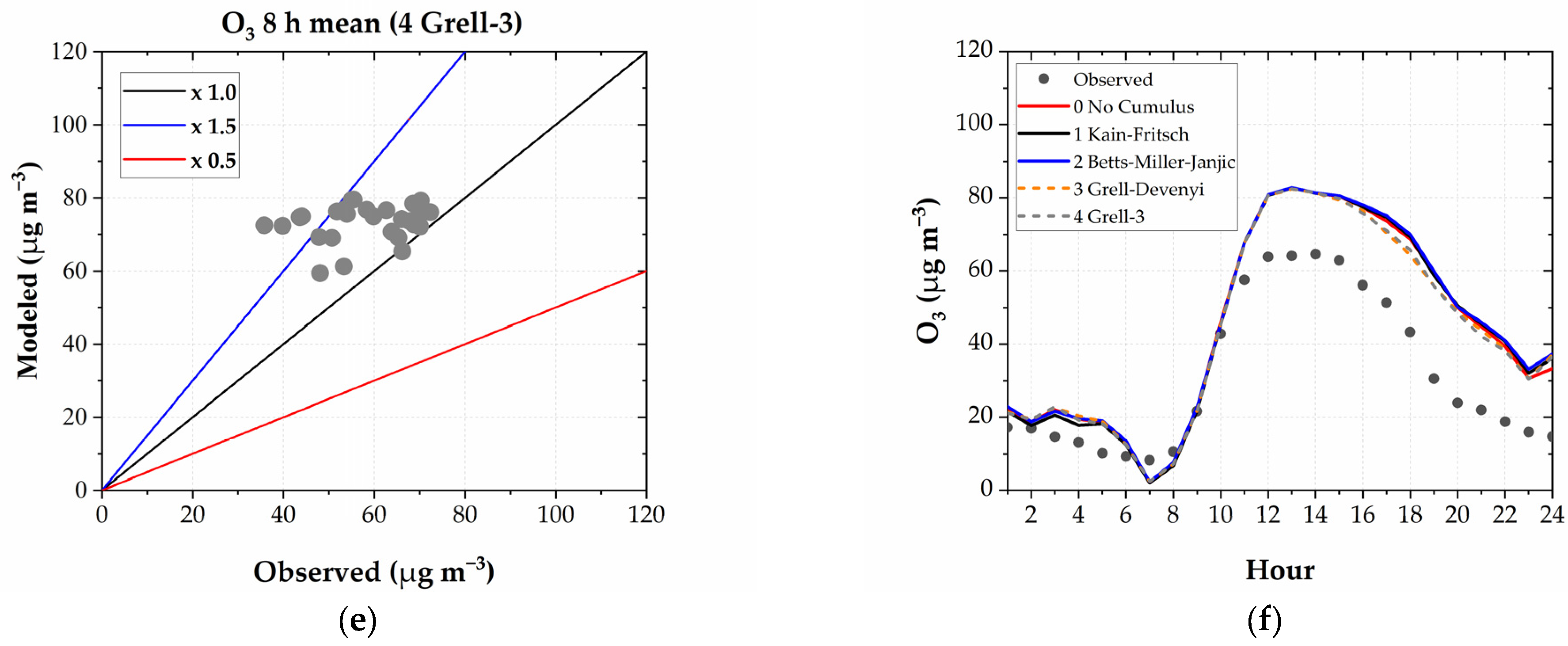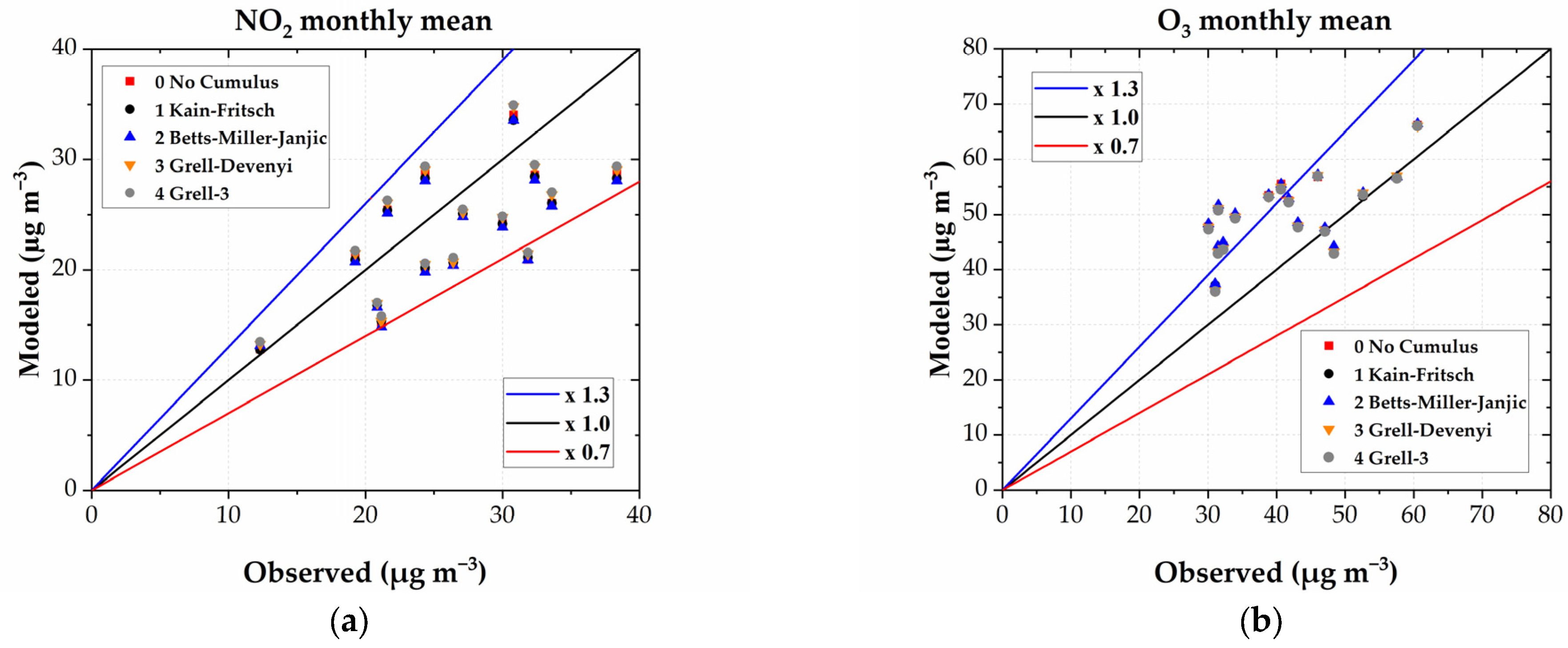1. Introduction
Air quality results from a complex interaction between atmospheric emissions and meteorology [
1]. For atmospheric modeling purposes, cumulus convection is a component typically parameterized. It is directly related to cloud formation and, therefore, to solar radiation and temperature at the surface, affecting other variables such as the planetary boundary layer depth and atmospheric stability.
Complex topography and land-use heterogeneity, as in the Andean Region of Ecuador, directly affect the atmospheric dynamic [
2], implying atmospheric modeling is challenging. For these cases, modeling with a spatial resolution of 1 km improves the topography and land-use representation. Atmospheric modeling was done in Cuenca, an Andean city in the southern of Ecuador (2500 masl,
Figure 1), using this spatial resolution for studying the influence of planetary boundary layer schemes [
3], for assessing the impact on air quality due to the shift from diesel to electric buses [
4] and the influence of feedback between aerosols and meteorology [
5]. Recently, schemes for modeling the interaction near the land–atmosphere interface were assessed through land surface schemes [
6]. These contributions identified options for improving the atmospheric modeling in this region, and although acceptable performances were achieved, other components, such as the cumulus options, deserve dedicated studies [
7].
Cumulus schemes model the sub-grid-scale effects of convective and shallow clouds. They represent the vertical fluxes due to unresolved updrafts and downdrafts and compensate for motion outside the clouds. Operating on individual columns, they provide vertical heating and moistening profiles. Some schemes offer column cloud and precipitation field tendencies [
8].
Cumulus parameterizations are theoretically only valid for coarser grid sizes (e.g., greater than 10 km), which are necessary to properly release latent heat on a realistic time scale in the convective columns. While the assumptions about the convective eddies being entirely sub-grid-scale break down for finer grid sizes, sometimes these schemes have been found to help trigger convection in 5–10 km grid applications. It is considered that generally, on a high-resolution grid, cumulus schemes should not be used when the model can resolve the convective eddies itself (e.g., ≤ 5 km grid) [
9]. The horizontal resolution of 1 km corresponds to the “grey zone,” a range that might not require modeling with cumulus convective parameterization [
10]. Modeling in the grey zone allows addressing whether working with higher resolution is always better [
11], and currently, it is a line of active research in atmospheric science. Chow et al. (2019) reviewed the limitations of convective schemes in reproducing observed precipitation [
2].
For modeling cumulus effects, the Weather Research and Forecasting with Chemistry model (WRF-Chem V3.2) offers four schemes (
Table 1) [
8]. Cumulus schemes use different approaches and perform best when the assumptions are better satisfied [
9].
The Kain-Fritsch scheme [
12] uses a simple cloud model with moist updrafts and downdrafts, including the effects of detrainment and entrainment and relatively simple microphysics.
The Betts-Miller-Janjic option [
13,
14] considers as variable the deep convection profiles and the relaxation time, depending on the cloud efficiency, which is a function of the entropy change, precipitation, and mean temperature of the cloud. The shallow convection moisture profile is based on the entropy change, which must be small and nonnegative.
The Grell-Devenyi option [
15] is an ensemble scheme using multiple cumulus models and variants within each grid box. The results are averaged to give feedback to the model. All the schemes are mass-flux types but have different updraft and downdraft entrainment and detrainment parameters and precipitation efficiencies. The dynamic control closures are based on the convective available potential energy, low-level vertical velocity, or moisture convergence.
The Grell-3 scheme [
15,
16] has features in common with the Grell and Devenyi scheme, in the same way, based on an ensemble approach, but the quasi-equilibrium approach is not included among the scheme members. The scheme allows the subsidence effects to spread to neighboring grid columns, making the method more suitable for smaller grid sizes than 10 km. It can also be used at larger grid sizes where subsidence occurs within the same grid column as the updraft.
Cloud microphysics is the other component in which clouds occur on the scales of the cloud droplets and hydrometeors [
9], modeling precipitation on the grid scale, which plays an essential role in modeling moist convection [
17]. Due to its scale, microphysical processes are always parameterized
The atmospheric modeling coupling meteorology and air quality within one integrated approach evolved over the last years, recognizing that meteorology strongly influences air quality, and weather and climate are affected by changes in atmospheric composition [
18]. Therefore, this contribution addresses the following questions:
• What cumulus parameterization scheme from WRF-Chem V3.2 provides the best performance for modeling meteorological and air quality variables in Cuenca?
• What is the effect of modeling without cumulus parameterization?
• What is the recommended option for holistically modeling meteorological and air quality variables?
4. Discussion and Conclusions
Applying the online approach, we used the WRF-Chem V3.2, a state-of-the-art atmospheric tool for modeling meteorological (surface temperature, wind speed, wind direction, rainfall) and air quality parameters (short-term: CO, PM
2.5, and O
3; long-term: NO
2 and O
3) in Cuenca, an Andean city of Southern Ecuador, in September of 2014, the month when typically the tropospheric O
3 concentrations are higher in the region. We made numerical experiments to assess the influence on the performance of the cumulus schemes coded in this model (Kain-Fritsch, Betts-Miller-Janjic, Grell–Devenyi, and Grell-3) and the option of modeling without cumulus parameterization, working with a spatial resolution of 1 km. This resolution corresponds to the grey zone, a range of 1 to 10 km for moist convection [
11], whose length scale can be similar in size and potentially without the need for convective parameterization.
The results indicated that no unique cumulus option was the best for modeling each of the assessed variables over the entire inner domain, suggesting that using no cumulus scheme could be beneficial for holistically modeling meteorological and air quality variables in the urban area of Cuenca, where rainfall modeling improved through the deactivation of a cumulus scheme. Over the urban area, cumulus schemes provided better performances for temperature, wind speed, and wind direction compared to modeling without cumulus schemes. On the contrary, all the options overestimated the total amount of modeled rainfall over the Cordillera during the simulation period. All options provided comparable modeling performances for short- and long-term simulations regarding air quality.
Published assessments about the influence of cumulus schemes at the grey zone mainly focused on precipitation modeling. We did not find studies covering meteorological and air quality variables for comparison purposes. Our finding over the urban area was consistent with Zhang et al. (2021) [
38] (
Table 12), who reported a clear improvement in modeling precipitation in the Central Great Plains of the United States without using a cumulus scheme at a 4 km resolution.
Similarly, Liang et al. (2019) [
39] assessed the sensitivity for modeling rainfall in Jiangsu, China, to model configurations of grid nesting and convection treatment, using grid spacings from 30, 15, 9, 5, 3 to 1 km, concluding that convective parameterization in 30–9 km grids is required to represent organized cumuli, while explicitly resolving convections in cloud-permitting grids around 1 km is necessary to improve forecasts.
Amirudin et al. (2022) [
40] performed simulations of precipitation over Peninsular Malaysia from 2013 to 2018 for assessing cumulus schemes at resolutions of 25, 5, and 1.6 km, reporting that at 5 km, the best performing scheme was the Betts–Miller–Janjic. The finest resolution at 1.6 km simulation showed significant added value as it was the only simulation to capture the high precipitation intensity in the morning and a precipitation peak during the evening. The authors indicated that cumulus schemes became less significant in a higher-resolution simulation.
Castorina et al. (2021) performed WRF’s simulations for modeling precipitation in Sicily (Italy) on 24 and 25 Nov 2016, working at 5 km. The authors reported that using no cumulus schemes provided the most reliable and accurate solution with the highest accuracy.
Table 12.
Comparison with other assessments on the influence of cumulus schemes.
Table 12.
Comparison with other assessments on the influence of cumulus schemes.
| Region |
Period |
Model |
Resolution and Parameters |
Main Results |
Reference |
| Andean Region of Ecuador (Cuenca) |
Sep 2014 |
WRF-Chem V3.2 |
1 km. Temperature, wind speed, wind direction, solar radiation, precipitation, air quality |
No unique cumulus option was the best for modeling each of the assessed meteorological parameters. All the options provided comparable performances for modeling air quality variables. Deactivating the cumulus scheme could be beneficial for holistically modeling meteorological and air quality variables in the urban area of Cuenca. |
This contribution |
| Central Great Plains, Eastern Kansas and western Missouri region (USA) |
Three summers, from 2002 to 2004 |
NU-WRF |
4 km. Precipitation |
There was a clear improvement without using a cumulus scheme, which should become more evident with finer resolutions such as 1 km. |
Zhang et al. (2021) [37] |
| Jiangsu, China |
19 Jun to 20 Jul 2016 |
WRF-3.9 |
30, 15, 9, 5, 3, 1 km. Precipitation |
Parameterization in 30–9 km grids is required to represent organized cumuli, while explicitly resolving convections in cloud-permitting grids around 1 km is necessary to improve forecasts. |
Liang et al. (2019) [38] |
| Peninsular Malaysia |
2013 to 2018 |
WRF |
25, 5, 1.6 km. Precipitation |
At 5 km, the best-performing scheme was the Betts–Miller—Janjic. The 1.6 km simulation showed significant added value as it was the only simulation that captured the high precipitation intensity in the morning and a precipitation peak during the evening. The role of cumulus schemes became less significant in a higher-resolution simulation. |
Amirudin et al. (2022) [39] |
| Andean Region of Ecuador (Cuenca) |
1 to 11 November 2020 |
WRF-4.0.3 |
1 km.Temperature, wind speed, solar radiation |
None of the cumulus options, including the deactivation of the cumulus scheme, adequately modeled the drop in temperature and solar radiation on 9 November 2020. |
Parra (2022) [41] |
| Shanghai |
25 May 2018, 10 June 2017 |
WRF |
27, 15, 9, 5, 3, 1 km. Extreme precipitation |
The primary rainfall peak at noon was best reproduced when the 1 km grid with explicit convection was nested directly into their outermost 15-km or 9-km grids using the Kain-Fritsch scheme. However, a secondary peak with a weak forcing was not detected. |
Wang et al. (2021) [42] |
| Sicily (Italy) |
24 to 25 November 2016 |
WRF |
5 km. Precipitation |
Using no cumulus schemes provided the most reliable and accurate solution with the highest accuracy. |
Castorina et al. (2021) [43] |
| The Netherlands |
23 to 24 June 2016 |
WRF 3.7.1 |
4, 2 km. Precipitation |
The Betts–Miller–Janjic scheme was activated too early and did not predict any convective system over the region of interest. The Grell–Freitas and Kain–Fritsch schemes predicted a convective system, but its intensity was underestimated. With the explicit convection (without cumulus scheme), the model resolved the storm, although with a delay and an overestimated intensity. |
Steeneveld and Peerlings (2020) [44] |
| South Korea |
15 to 16 July 2017 |
WRF |
4km. Extreme precipitation |
Simulating convection processes in the grey zone without the convective parameterization scheme is inadequate. |
Park et al. (2022) [45] |
| South Korea |
26 to 27 July 2011 |
WRF |
27, 9, 3, 1 km. Extreme precipitation |
Multiple spurious cores occurred when the cumulus parameterization scheme was removed at 3 and 1 km of resolution. |
Kwon and Hong (2017) [46] |
Steeneveld and Peerlings (2020) [
44] modeled a severe summer thunderstorm in The Netherlands, which took place on 3 June 2016, working at 4 and 2 km of resolution. They found that the Betts–Miller–Janjic scheme was activated too early and did not predict any convective system over the region of interest. The Grell–Freitas and Kain–Fritsch schemes predicted a convective system, but its intensity was underestimated. With the explicit convection, the model was able to resolve the storm. The authors indicated that modeling with the explicit convection (without cumulus scheme), the model captured the storm, although with a delay and an overestimated intensity.
On the contrary, other studies concluded that modeling in the grey zone without cumulus parameterization is inadequate. In this sense, Park et al. (2022) [
45] performed WRF simulations with cumulus schemes and explicit convection (no convective parameterization) in South Korea, concluding that simulating convection processes using explicitly resolved convection leads to overestimations and erroneous precipitation locations.
Kwon and Hong (2017) [
46] modeled a heavy rain event in South Korea using an updated version of a cumulus scheme and performed simulations with 3 and 1 km resolution without the cumulus option. They reported that an updated cumulus scheme outperformed the original version, and at 3 and 1 km, the precipitation core was well reproduced. On the contrary, multiple spurious cores occurred when the cumulus scheme was removed at those resolutions.
Other contributions as by Wang et al. (2021) [
42], who studied convection representation across the grey zone in forecasting warm-season extreme precipitation over Shanghai, reported that the use of cumulus schemes is beneficial at the 5 km grid resolution in simulating both powerful intensity and diurnal variations, although with mixed effects at 3 km. The primary rainfall peak at noon was best reproduced when the 1 km grid with explicit convection was nested directly into their outermost 15-km or 9-km grids using the Kain-Fritsch scheme. However, a secondary peak with a weak forcing was not detected.
Our findings and the literature cited highlight the importance of dedicated studies to assess the effects of deactivating the cumulus parameterization on atmospheric modeling in the grey zone.
On average, CO levels were adequately modeled regarding air quality, especially from 06:00 to 10:00, suggesting that emissions and parameters involved in air dispersion, such as planetary boundary layer depth and atmospheric stability, were acceptably modeled during peak CO emissions. For other hours, CO levels were underestimated by about 0.5 mg m-3. The overestimation of surface solar radiation and temperature around midday implies an overestimation of the planetary boundary layer depth during these hours and, therefore, the underestimation of CO concentrations.
On average, the hourly peak level of PM2.5 was modeled at 08:00, two hours earlier than the records, which implies that the estimation of the hourly PM2.5 emissions, especially from diesel cars, needs to be reviewed.
The overestimation of surface solar radiation implies a higher level of photochemical reactions that promote and partly explain the overestimation of the peak O3. However, the generation and behavior of O3 are more complex due to the participation of emissions of nitrogen oxides and volatile organic compounds under the influence of solar radiation. Overestimation of O3 can also be contributed to by an inadequate estimation of emissions.
Based on the findings of the present contribution and from previous studies, we recommend the following configuration for modeling the meteorology and air quality over the urban area of Cuenca:
The proposed configuration needs to be assessed for days with significant changes in meteorological conditions, such as a sudden drop in temperature and solar radiation, as of 9 November 2020, which was not adequately modeled by any of the cumulus options, including the deactivation of the cumulus scheme [
41] (
Table 12).
As all the options, including the deactivation of the cumulus scheme, overestimated the total amount of precipitation over the Cordillera, its modeling needs to be improved, particularly for studies on water supply, hydrological management, extreme rainfall events, and the influence of climate change. Hydropower energy is a critical component of the Ecuadorian mix generation and needs to be assessed correctly in terms of the influence of climate change [
47,
48]. Although all the options provided acceptable performances for air quality, the impact of modeled rainfall over the Cordillera and the overestimation of global solar radiation at the surface needs to be assessed, considering that the emission inventory data has high uncertainties.
Atmospheric modeling is particularly challenging in the Andean Region of Ecuador [
49] due to the influence of the Cordillera chain, the dynamic of the intertropical converge zone, the breezes coming from the Coast and Amazonian regions, which promote convective movements with complex cloud dynamics, with division between the Pacific area west of the western Cordillera, which shows lower and more stratiform clouds, and the eastern parts with an increased average cloud-top height towards the Amazon region [
50].
Performance for modeling rainfall was done in this contribution, based on daily intensities, through the ability of the model to capture days without and with rain. A more comprehensive assessment can incorporate a comparison between computed precipitation and records per precipitation ranges based on hourly intensities.
Although the availability of atmospheric records is low in the Andean Region of Ecuador [
51,
52], new assessments should include measurements from stations, such as from the western part of the urban area over the Cordillera chain, where the computed precipitation indicated that both convective (cumulus) and the microphysics components can be relevant. The Paute River basin, which is partially located in our study region, shows a high spatial variability of rainfall and temperature [
53,
54]. In complex topography, numerical models have shortcomings in capturing the distribution of rain with altitude [
55]. Physics parameterization schemes have been developed and tested mainly for the Northern Hemisphere. The features of the Tropical Andean Region could demand the proposal of dedicated physics schemes to improve atmospheric modeling.
This contribution provided insights for atmospheric modeling in the grey zone of spatial resolution over the Andean Region of Ecuador, improving our understanding of the influence of cumulus schemes and options for modeling, at the same time, meteorological and air quality variables, which is a valuable feature, considering that in most of the studies, we found that mainly precipitation was assessed.
The activation of indirect effects between meteorology and aerosols for modeling in the Andean Region is a component that deserves future research. Other elements need to be assessed, such as the microphysics parameterization, which determines the cloud life cycle and interaction between clouds and aerosols, affecting the solar radiation levels at the surface and rainfall processes. In addition, assessments of recent versions of WRF-Chem, other periods of dry and wet seasons, the data assimilation of records and remote sensing monitoring, and even the combination with artificial intelligence approaches are necessary.
Figure 1.
Location of: (a) Ecuador and (b,c) Cantón Cuenca. (d) The urban area of Cuenca (blue border) and the air quality network (white dots). Orange dots (northwest) indicate the artisanal brick producers. Black dots indicate meteorological stations. Grey dots indicate industries. MUN is the automatic station located at the historic center. White dots indicate passive stations. Black dots ic (c) indicate the location of meteorological stations.
Figure 1.
Location of: (a) Ecuador and (b,c) Cantón Cuenca. (d) The urban area of Cuenca (blue border) and the air quality network (white dots). Orange dots (northwest) indicate the artisanal brick producers. Black dots indicate meteorological stations. Grey dots indicate industries. MUN is the automatic station located at the historic center. White dots indicate passive stations. Black dots ic (c) indicate the location of meteorological stations.
Figure 2.
MUN station. Daily mean profiles during September 2014: (a) Temperature. (b) Global solar radiation. (c) Wind speed. (d) Wind direction.
Figure 2.
MUN station. Daily mean profiles during September 2014: (a) Temperature. (b) Global solar radiation. (c) Wind speed. (d) Wind direction.
Figure 3.
Rainfall records at the MUN station and modeled values (mm d-1): (a) contribution of cumulus parameterization (RAINC variable from WRF-Chem), (b) contribution of microphysics (RAINNC variable from WRF-Chem), (c) cumulus and microphysics (RAINC and RAINNC).
Figure 3.
Rainfall records at the MUN station and modeled values (mm d-1): (a) contribution of cumulus parameterization (RAINC variable from WRF-Chem), (b) contribution of microphysics (RAINNC variable from WRF-Chem), (c) cumulus and microphysics (RAINC and RAINNC).
Figure 4.
Modeled rainfall (mm d-1) contribution from cumulus parameterization (RAINC), microphysics (RAINNC), and total (RAINC+RAINNC) for 20-Sep-2014: (a–c) 0 No Cumulus, (d–f) 1 Kaint-Fritsch, (g–i) 2 Betts-Miller-Janjic, (j–l) 3 Grell-Devenyi, (m–o) 4 Grell-3.
Figure 4.
Modeled rainfall (mm d-1) contribution from cumulus parameterization (RAINC), microphysics (RAINNC), and total (RAINC+RAINNC) for 20-Sep-2014: (a–c) 0 No Cumulus, (d–f) 1 Kaint-Fritsch, (g–i) 2 Betts-Miller-Janjic, (j–l) 3 Grell-Devenyi, (m–o) 4 Grell-3.
Figure 5.
Modeled rainfall (mm d-1) contribution from cumulus parameterization (RAINC), microphysics (RAINNC), and total (RAINC+RAINNC) for 22-Sep-2014: (a–c) 0 No Cumulus, (d–f) 1 Kaint-Fritsch, (g–i) 2 Betts-Miller-Janjic, (j–l) 3 Grell-Devenyi, (m–o) 4 Grell-3.
Figure 5.
Modeled rainfall (mm d-1) contribution from cumulus parameterization (RAINC), microphysics (RAINNC), and total (RAINC+RAINNC) for 22-Sep-2014: (a–c) 0 No Cumulus, (d–f) 1 Kaint-Fritsch, (g–i) 2 Betts-Miller-Janjic, (j–l) 3 Grell-Devenyi, (m–o) 4 Grell-3.
Figure 6.
Observed versus modeled daily CO 8 h maximum: (a) 0 No Cumulus; (b) 1 Kain-Fritsch; (c) 2 Betts-Miller-Janjic; (d) 3 Grell-Devenyi; (e) 4 Grell-3. (f) Mean daily profiles of hourly CO concentrations.
Figure 6.
Observed versus modeled daily CO 8 h maximum: (a) 0 No Cumulus; (b) 1 Kain-Fritsch; (c) 2 Betts-Miller-Janjic; (d) 3 Grell-Devenyi; (e) 4 Grell-3. (f) Mean daily profiles of hourly CO concentrations.
Figure 7.
Observed versus modeled daily PM2.5 24 h mean: (a) 0 No Cumulus; (b) 1 Kain-Fritsch; (c) 2 Betts-Miller-Janjic; (d) 3 Grell-Devenyi; (e) 4 Grell-3. (f) Mean daily profiles of hourly PM2.5 concentrations.
Figure 7.
Observed versus modeled daily PM2.5 24 h mean: (a) 0 No Cumulus; (b) 1 Kain-Fritsch; (c) 2 Betts-Miller-Janjic; (d) 3 Grell-Devenyi; (e) 4 Grell-3. (f) Mean daily profiles of hourly PM2.5 concentrations.
Figure 8.
Observed versus modeled daily O3 8 h maximum mean: (a) 0 No Cumulus; (b) 1 Kain-Fritsch; (c) 2 Betts-Miller-Janjic; (d) 3 Grell-Devenyi; (e) 4 Grell-3. (f) Mean daily profiles of hourly O3 concentrations.
Figure 8.
Observed versus modeled daily O3 8 h maximum mean: (a) 0 No Cumulus; (b) 1 Kain-Fritsch; (c) 2 Betts-Miller-Janjic; (d) 3 Grell-Devenyi; (e) 4 Grell-3. (f) Mean daily profiles of hourly O3 concentrations.
Figure 9.
Passive stations: Observed versus modeled monthly means concentrations: (a) NO2 and (b) O3.
Figure 9.
Passive stations: Observed versus modeled monthly means concentrations: (a) NO2 and (b) O3.
Table 1.
Cumulus options in the WRF-Chem V3.2, based on [
8].
Table 1.
Cumulus options in the WRF-Chem V3.2, based on [
8].
| Option |
Nomenclature |
Cloud Detrainment |
Type |
Closure |
| 0 |
0 No Cumulus |
|
|
|
| 1 |
1 Kain-Fritsch |
Yes |
Mass flux |
Convective Available Potential Energy (CAPE) removal |
| 2 |
2 Betts-Miller-Janjic |
No |
Adjustment |
Sounding adjustment |
| 3 |
3 Grell-Devenyi |
Yes |
Mass flux |
Various |
| 5 |
4 Grell-3 |
Yes |
Mass flux |
Various |
Table 2.
Meteorological stations and parameters used in this study.
Table 2.
Meteorological stations and parameters used in this study.
| Station |
Nomenclature |
Entity |
masl |
Parameters |
| Municipio |
MUN |
EMOV EP |
2582 |
Temperature, wind speed and direction, solar radiation, rainfall |
| Sayausí |
SAY |
ETAPA EP |
2622 |
Temperature, rainfall |
| Mamamag |
MAM |
ETAPA EP |
3609 |
Temperature, rainfall |
| Ventanas |
VEN |
ETAPA EP |
3944 |
Temperature, rainfall |
| Izhcairrumi |
IZH |
ETAPA EP |
3018 |
Temperature, rainfall |
| Soldados |
SOL |
ETAPA EP |
3466 |
Temperature, rainfall |
Table 3.
Schemes and options selected for atmospheric modeling in Cuenca (WRF-Chem V3.2).
Table 3.
Schemes and options selected for atmospheric modeling in Cuenca (WRF-Chem V3.2).
| Component and WRF-Chem Option Nomenclature |
WRF-Chem Option |
Model, Description, and References |
| Microphysics (mp_physics) |
4 |
WRF Single–moment 5–class (Hong et al., 2004) [27] |
| Longwave Radiation (ra_lw_physics) |
1 |
RRTM (Mlawer et al., 1997) [28] |
| Shortwave Radiation (ra_sw_physics) |
2 |
Goddard (Chou and Suarez, 1999) [29] |
| Surface Layer (sf_clay_physics) |
1 |
MM5 similarity (Paulson, 1970) [30] |
| Planetary Boundary Layer (bl_pbl_physics) |
1 |
Yonsei University (Hong et al., 2006) [31] |
Cumulus Parameterization
(cu_physics) |
0 |
0 No Cumulus |
| 1 |
1 Kain-Fritsch [12] |
| 2 |
2 Betts-Miller-Janjic [13,14] |
| 3 |
3 Grell-Devenyi [15] |
| 5 |
4 Grell-3 [15,16] |
| Options of chemical mechanisms and aerosol modules (chem_opt) |
7 |
CBMZ (Zaveri and Peters, 1999) and MOSAIC
(4 sectional aerosol bins) (Zaveri et al., 2008) [25,26] |
| Land Surface (sf_surface_physics) |
2 |
(Chen and Dudhia, 2001) [32] |
| Urban surface (sf_urban_physics) |
0 |
No urban physics |
Table 4.
Metrics for modeling atmospheric variables [
33,
34].
Table 4.
Metrics for modeling atmospheric variables [
33,
34].
| Variable |
Metric |
Benchmark or
Ideal Value |
Accuracy |
| Hourly surface temperature |
GE |
<2 °C |
±2 °C |
| MB |
<±0.5 °C |
| IOA |
≥0.8 |
| Hourly wind speed (10 mas) |
RMSE |
<2 m s−1
|
±1 m s−1
|
| MB |
<±0.5 m s−1
|
| IOA |
≥0.6 |
| Hourly wind direction (10 mas) |
GE |
<30° |
±30° |
| MB |
<±10° |
| Short-term air quality: Maximum 1 h CO mean, maximum 8 h CO mean, 24 h PM2.5 mean, maximum 8 h O3 mean |
MB |
0 |
±50% |
| RMSE |
0 |
| FB |
0 |
| MNB |
0 |
| r |
1 |
| Long-term air quality: NO2 and O3
|
|
|
±30% |
Table 5.
Metrics for the meteorological modeling. Bold numbers indicate values in the benchmark ranges. MUN station.
Table 5.
Metrics for the meteorological modeling. Bold numbers indicate values in the benchmark ranges. MUN station.
Cumulus
Option: |
0 No Cumulus |
1 Kain-Fritsch |
2 Betts-Miller-Janjic |
3 Grell–Devenyi |
4 Grell-3 |
Benchmark |
| Hourly surface temperature: |
| GE |
1.3 |
1.3 |
1.3 |
1.3 |
1.3 |
<2 °C |
| MB |
0.2 |
0.2 |
0.2 |
0.1 |
0.1 |
<±0.5 °C |
| IOA |
0.9 |
0.9 |
0.9 |
0.9 |
0.9 |
≥0.8 |
| Hourly wind speed: |
| RMSE |
1.0 |
1.0 |
1.0 |
0.9 |
0.9 |
<2 m s−1 |
| MB |
0.4 |
0.4 |
0.4 |
0.2 |
0.2 |
<±0.5 m s−1 |
| IOA |
0.8 |
0.8 |
0.8 |
0.9 |
0.9 |
≥0.6 |
| Hourly wind direction: |
| GE |
63.5 |
62.2 |
62.4 |
61.7 |
61.9 |
<30° |
| MB |
-23.5 |
-23.5 |
-23.9 |
-20.5 |
-20.8 |
<±10° |
Table 6.
Metrics for the meteorological modeling. Bold numbers indicate values in the benchmark ranges—other stations.
Table 6.
Metrics for the meteorological modeling. Bold numbers indicate values in the benchmark ranges—other stations.
Cumulus
Option: |
0 No Cumulus |
1 Kain-Fritsch |
2 Betts-Miller-Janjic |
3 Grell–Devenyi |
4 Grell-3 |
Benchmark |
| Hourly surface temperature: SAY station |
| GE |
1.8 |
1.7 |
1.7 |
1.8 |
1.8 |
<2 °C |
| MB |
-1.2 |
-1.2 |
-1.2 |
-1.3 |
-1.3 |
<±0.5 °C |
| IOA |
0.9 |
0.9 |
0.9 |
0.9 |
0.9 |
≥0.8 |
| Hourly surface temperature: MAM station |
| GE |
2.0 |
2.0 |
2.0 |
2.0 |
2.0 |
<2 °C |
| MB |
-1.8 |
-1.7 |
-1.7 |
-1.7 |
-1.7 |
<±0.5 °C |
| IOA |
0.8 |
0.8 |
0.8 |
0.8 |
0.8 |
≥0.8 |
| Hourly surface temperature: VEN station |
| GE |
1.1 |
1.1 |
1.1 |
1.1 |
1.1 |
<2 °C |
| MB |
0.0 |
0.1 |
0.1 |
0.0 |
0.0 |
<±0.5 °C |
| IOA |
0.9 |
0.9 |
0.9 |
0.9 |
0.9 |
≥0.8 |
| Hourly surface temperature: IZH station |
| GE |
1.2 |
1.2 |
1.2 |
1.2 |
1.2 |
<2 °C |
| MB |
-0.2 |
-0.2 |
-0.1 |
-0.2 |
-0.2 |
<±0.5 °C |
| IOA |
0.9 |
0.9 |
0.9 |
0.9 |
0.9 |
≥0.8 |
| Hourly surface temperature: SOL station |
| GE |
2.3 |
2.3 |
2.3 |
2.3 |
2.3 |
<2 °C |
| MB |
-1.7 |
-1.7 |
-1.7 |
-1.8 |
-1.8 |
<±0.5 °C |
| IOA |
0.8 |
0.8 |
0.8 |
0.8 |
0.8 |
≥0.8 |
Table 7.
Percentages of the records captured by modeling. Meteorological variables. Bold numbers highlight the schemes with the best performances. MUN station.
Table 7.
Percentages of the records captured by modeling. Meteorological variables. Bold numbers highlight the schemes with the best performances. MUN station.
| Cumulus Option: |
0 No Cumulus |
1 Kain-Fritsch |
2 Betts-Miller-Janjic |
3 Grell–Devenyi |
4 Grell-3 |
Records |
| Hourly surface temperature |
77.8 |
78.7 |
78.1 |
77.0 |
78.0 |
644 |
| Hourly wind speed |
73.9 |
74.1 |
73.8 |
77.0 |
76.9 |
644 |
| Hourly wind direction |
36.6 |
37.1 |
37.0 |
37.9 |
37.1 |
644 |
| Daily rainfall |
77.8 |
70.4 |
63.0 |
66.7 |
63.0 |
27 |
| Average |
66.5 |
65.1 |
62.9 |
64.6 |
63.7 |
|
Table 8.
Percentages of hourly temperature and daily precipitation records captured by modeling. Bold numbers highlight the schemes with the best performances.
Table 8.
Percentages of hourly temperature and daily precipitation records captured by modeling. Bold numbers highlight the schemes with the best performances.
| Station |
0 No Cumulus |
1 Kain-Fritsch |
2 Betts-Miller-Janjic |
3 Grell–Devenyi |
4 Grell-3 |
Records |
| Hourly surface temperature |
| SAY |
62.7 |
63.2 |
63.0 |
62.3 |
61.8 |
644 |
| MAM |
58.1 |
60.1 |
59.8 |
58.2 |
57.3 |
644 |
| VEN |
83.2 |
83.9 |
83.2 |
85.4 |
85.2 |
644 |
| IZH |
81.4 |
81.2 |
81.1 |
82.0 |
80.9 |
644 |
| SOL |
43.8 |
43.3 |
46.1 |
42.7 |
43.5 |
644 |
| Daily rainfall |
| SAY |
63.0 |
59.3 |
55.6 |
63.0 |
63.0 |
27 |
| MAM |
59.3 |
74.1 |
63.0 |
55.6 |
63.0 |
27 |
| VEN |
70.4 |
70.4 |
63.0 |
66.7 |
66.7 |
27 |
| IZH |
59.3 |
55.6 |
48.1 |
63.0 |
63.0 |
27 |
| SOL |
74.1 |
66.7 |
77.8 |
74.1 |
66.7 |
27 |
Table 9.
Rainfall records and modeled values from 1 to 27 Sep 2014. Bold numbers indicate the options with differences lower than 50%.
Table 9.
Rainfall records and modeled values from 1 to 27 Sep 2014. Bold numbers indicate the options with differences lower than 50%.
| Station |
Records |
0 No Cumulus |
1 Kain-Fritsch |
2 Betts-Miller-Janjic |
3 Grell–Devenyi |
4 Grell-3 |
| Total rainfall (records, mm) |
| MUN |
36.7 |
31.9 |
39.4 |
42.7 |
94.2 |
119.8 |
| SAY |
55.8 |
39.7 |
103.1 |
100.3 |
160.4 |
186.8 |
| MAM |
77.8 |
108.5 |
128.9 |
81.8 |
110.5 |
127.5 |
| VEN |
49.9 |
154.9 |
141.5 |
105.5 |
80.2 |
85.5 |
| IZH |
56.7 |
135.2 |
147.0 |
119.8 |
112.4 |
124.0 |
| SOL |
54.7 |
106.2 |
113.2 |
77.4 |
86.4 |
104.8 |
| (Total modeled rainfall – Total rainfall)/(Total rainfall)*100 |
| MUN |
|
-13.2 |
7.3 |
16.3 |
156.6 |
226.3 |
| SAY |
|
-28.8 |
84.8 |
79.7 |
187.5 |
234.7 |
| MAM |
|
39.4 |
65.7 |
5.2 |
42.0 |
63.9 |
| VEN |
|
210.4 |
183.6 |
111.3 |
60.6 |
71.4 |
| IZH |
|
138.5 |
159.2 |
111.4 |
98.3 |
118.7 |
| SOL |
|
94.1 |
107.0 |
41.6 |
58.0 |
91.5 |
Table 10.
Metrics for short-term air quality modeling. Bold numbers highlight the schemes with the best performances.
Table 10.
Metrics for short-term air quality modeling. Bold numbers highlight the schemes with the best performances.
| Cumulus Option: |
0 No Cumulus |
1 Kain-Fritsch |
2 Betts-Miller-Janjic |
3 Grell–Devenyi |
4 Grell-3 |
Ideal Value |
| Maximum 1 h CO mean: |
| MB |
0.10 |
0.11 |
0.08 |
0.11 |
0.10 |
0 |
| RMSE |
0.55 |
0.55 |
0.54 |
0.57 |
0.56 |
0 |
| FB |
5.6 |
6.5 |
4.6 |
6.5 |
6.1 |
0 |
| MNB |
7.09 |
8.55 |
6.35 |
9.11 |
8.42 |
0 |
| r |
0.47 |
0.45 |
0.46 |
0.38 |
0.41 |
1 |
| Maximum 8 h CO mean: |
| MB |
-0.08 |
-0.08 |
-0.09 |
-0.08 |
-0.08 |
0 |
| RMSE |
0.20 |
0.20 |
0.20 |
0.21 |
0.20 |
0 |
| FB |
-10.4 |
-10.2 |
-11.1 |
-9.8 |
-9.9 |
0 |
| MNB |
-9.56 |
-9.20 |
-10.04 |
-8.67 |
-8.81 |
0 |
| r |
0.45 |
0.43 |
0.43 |
0.38 |
0.39 |
1 |
| 24 h PM2.5 mean: |
| MB |
1.02 |
1.05 |
0.87 |
1.17 |
1.17 |
0 |
| RMSE |
3.16 |
3.16 |
3.10 |
3.22 |
3.25 |
0 |
| FB |
14.9 |
15.2 |
12.8 |
16.8 |
16.8 |
0 |
| MNB |
41.76 |
42.19 |
39.08 |
44.95 |
45.73 |
0 |
| r |
0.07 |
0.06 |
0.05 |
0.04 |
0.01 |
1 |
| Maximum 8 h O3 mean: |
| MB |
15.86 |
15.92 |
16.09 |
15.29 |
15.29 |
0 |
| RMSE |
18.83 |
18.80 |
18.93 |
18.54 |
18.51 |
0 |
| FB |
24.1 |
24.2 |
24.4 |
23.3 |
23.3 |
0 |
| MNB |
31.50 |
31.61 |
31.92 |
30.61 |
30.61 |
0 |
| r |
0.26 |
0.28 |
0.28 |
0.19 |
0.20 |
1 |
Table 11.
Percentages of the records that were captured by modeling. Air quality variables. Bold numbers highlight the schemes with the best performances.
Table 11.
Percentages of the records that were captured by modeling. Air quality variables. Bold numbers highlight the schemes with the best performances.
| Cumulus Option: |
0 No Cumulus |
1 Kain-Fritsch |
2 Betts-Miller-Janjic |
3 Grell–Devenyi |
4 Grell-3 |
Records |
| Short-term air quality: |
| Max. 1 h CO mean |
96.3 |
96.3 |
88.9 |
92.6 |
92.6 |
27 |
| Max. 8 h CO mean |
96.3 |
100.0 |
96.3 |
100.0 |
100.0 |
27 |
| 24 h PM2.5 mean |
63.0 |
63.0 |
63.0 |
63.0 |
63.0 |
27 |
| Max. 8 h O3 mean |
81.5 |
81.5 |
81.5 |
85.2 |
85.2 |
27 |
| Average: |
84.3 |
85.2 |
82.4 |
85.2 |
85.2 |
|
| Long-term air quality: |
| NO2, monthly mean |
93.3 |
93.3 |
93.3 |
93.3 |
93.3 |
15 |
| O3, monthly mean |
56.3 |
56.3 |
56.3 |
56.3 |
56.3 |
16 |
| Average: |
74.8 |
74.8 |
74.8 |
74.8 |
74.8 |
|
